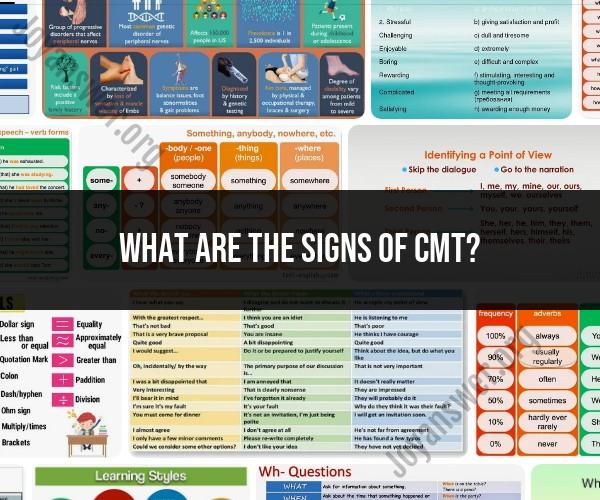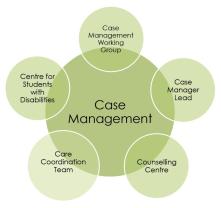What are the signs of CMT?
Charcot-Marie-Tooth disease (CMT) is a hereditary, progressive neurological disorder that affects the peripheral nerves. It can manifest with various signs and symptoms, and the severity of these symptoms can vary among individuals. Some common signs and symptoms of CMT may include:
Muscle Weakness: Muscle weakness, particularly in the lower legs and feet, is a hallmark of CMT. This can lead to difficulty walking, frequent tripping or falling, and problems with balance.
Foot Deformities: CMT can cause deformities in the feet, such as high arches (pes cavus) or flat feet. These deformities can contribute to balance and walking difficulties.
Muscle Atrophy: Over time, the muscles in the lower legs and hands may atrophy (shrink) due to the loss of nerve signals to these areas.
Sensory Changes: People with CMT may experience sensory changes, such as decreased sensation, numbness, or tingling in the extremities, which can affect the ability to feel heat, cold, or pain.
Foot Drop: A common symptom of CMT is "foot drop," where it becomes difficult to lift the front part of the foot when walking, resulting in a slapping gait.
Loss of Reflexes: Reflexes may be diminished or absent, particularly in the ankles and knees.
Hand Weakness: In some cases, weakness and muscle atrophy can also affect the hands, leading to difficulties with fine motor skills and grip strength.
Progression: CMT is a progressive disorder, meaning that symptoms tend to worsen over time. The rate and degree of progression can vary among individuals.
Fatigue: Muscle weakness and the effort required for daily activities may lead to increased fatigue.
Balance and Coordination Issues: Many individuals with CMT experience balance and coordination problems, which can make activities like walking, climbing stairs, and standing difficult.
It's important to note that there are different subtypes of CMT, each with its own genetic cause and specific symptoms. Some forms of CMT may also involve other health issues, such as scoliosis (curvature of the spine) or problems with the respiratory system.
If you or someone you know is experiencing symptoms that may be indicative of CMT, it is important to seek medical evaluation and genetic testing for an accurate diagnosis. Early diagnosis and management can help improve the quality of life for individuals with CMT. Additionally, a genetic counselor can provide information about the inheritance pattern and the risk of passing the condition to future generations.
Recognizing the Signs and Symptoms of CMT (Charcot-Marie-Tooth Disease)
Charcot-Marie-Tooth (CMT) disease is a group of inherited disorders that damage the peripheral nerves. These nerves carry signals from the brain and spinal cord to the muscles and relay sensations, such as pain and touch, to the brain and spinal cord from the rest of the body.
The symptoms of CMT usually begin in the feet and legs and may eventually affect the hands and arms. The most common symptoms include:
- Muscle weakness and atrophy (wasting) in the feet and legs
- Difficulty walking, running, and maintaining balance
- Foot deformities, such as hammertoes, high arches, and claw toes
- Loss of sensation in the feet and legs
- Cramps and muscle contractions
- Fatigue
- Pain
The severity of CMT symptoms varies from person to person. Some people may experience mild symptoms that do not interfere with their daily activities, while others may develop severe disabilities.
Overview of CMT: Causes, Types, and Prevalence
CMT is caused by mutations in genes that affect the peripheral nerves. These mutations can damage the nerves themselves or the myelin sheath, which is the protective coating that surrounds the nerves.
There are over 100 types of CMT, each caused by a different genetic mutation. Some of the most common types of CMT include:
- CMT1: This is the most common type of CMT, accounting for about 70% of all cases. It is caused by mutations in genes that affect the myelin sheath.
- CMT2: This is the second most common type of CMT, accounting for about 15% of all cases. It is caused by mutations in genes that affect the axons, which are the long, slender fibers that carry signals within the nerves.
- CMTX: This is a rarer form of CMT that is caused by mutations in genes located on the X chromosome. It is more common in males than in females.
CMT is a relatively common genetic disorder, affecting about 1 in 2,500 people. It can affect people of all ages, but it typically develops in childhood or adolescence.
Diagnosing CMT: Medical Tests and Genetic Screening
There is no single test that can definitively diagnose CMT. However, a doctor may order a combination of tests to assess nerve function and rule out other possible causes of the symptoms.
These tests may include:
- Physical exam: The doctor will perform a physical exam to assess muscle strength, sensation, and reflexes.
- Nerve conduction studies: These tests measure the speed at which electrical signals travel through the nerves.
- Electromyography (EMG): This test measures the electrical activity of the muscles.
- Genetic testing: Genetic testing can be used to identify the specific genetic mutation that is causing CMT.
Management and Treatment Options for CMT
There is no cure for CMT, but there are a number of treatments that can help to manage the symptoms and improve quality of life.
These treatments may include:
- Physical therapy: Physical therapy can help to strengthen the muscles, improve balance and coordination, and prevent foot deformities.
- Occupational therapy: Occupational therapy can help people with CMT to adapt to their activities of daily living and to use assistive devices, such as braces or canes.
- Medications: Medications such as pain relievers and muscle relaxants can be used to manage symptoms such as pain and cramping.
- Surgery: Surgery may be recommended to correct foot deformities or to relieve pressure on nerves.
Living with CMT: Coping Strategies and Support for Patients
Living with CMT can be challenging, but there are a number of things that people can do to cope and to live full and active lives.
Some helpful coping strategies include:
- Learning about CMT: Understanding the disorder and its symptoms can help people to cope with the challenges of CMT.
- Staying active: Regular exercise is important for people with CMT to maintain muscle strength and improve cardiovascular health.
- Getting support: There are a number of support groups and organizations available for people with CMT and their families. These groups can provide emotional support and practical advice.
If you or someone you know has been diagnosed with CMT, it is important to remember that you are not alone. There is a wealth of information and support available to help you manage the disorder and live a fulfilling life.












